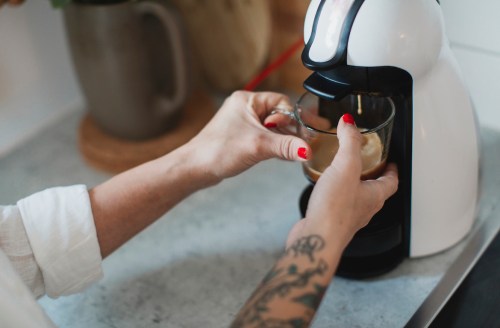A morning is not a morning without a cup of coffee. But while you might meticulously plan your next fancy at-home latte, or dream about the next time you can go to your favorite coffee shop, you’re probably not spending that much time thinking about how to clean your coffee maker.
Experts in This Article
Abe Navas is the general manager at house cleaning company Emily’s Maids in Dallas, Texas.
Dean Davies is a cleaning expert at the UK-based company Fantastic Services.
Jamie Hickey is a certified barista and the founder of the website Coffee Semantics.
But that’s a mistake—because the cleanliness of your coffee machine (or Nespresso, or Keurig, or French press) directly impacts the deliciousness of your morning Joe. Yet it’s not always as simple as using some soap and water and calling it a day. Here, we asked some coffee and cleaning experts to share some coffee maker cleaning tips, along with the biggest mistakes to avoid that are impacting the flavor and health of your brew.
Coffee isn’t just delicious—it’s loaded with tons of health benefits, too:
1. Only cleaning the carafe…
The biggest mistake people make when cleaning their coffee pot is only cleaning the carafe. “You need to clean every removable part and soak it in soapy hot water for 15 minutes,” says Jamie Hickey, a barista and founder of Coffee Semantics. (Note this down as one of the most important coffee maker cleaning tips, okay?)
“Your coffee maker is a hotbed for mold and bacteria, and if you don’t clean it regularly it will negatively affect the flavor and can make you sick,” he says. Put it in the dishwasher and use the heated water to kill any bacteria.
2. …Or not cleaning the carafe enough
Please, don’t just rinse out the carafe and call it a day. The carafe contains stains and other mineral content left by used coffee. Leaving your carafe dirty over a longer period of time will solidify the stain, making it harder to clean.
Clean your carafe regularly. If you notice any persistent stains, use baking soda to get rid of them and if that does not do the trick, add vinegar to the mix, says Dean Davies, cleaning expert at Fantastic Services. After cleaning your carafe, put it upside down on a paper towel until completely dry.
3. Not descaling your machine
Descaling basically cleans off excess mineral buildup, coffee oils, and germs and bacteria that build up inside your machine. And it’s important to do regularly to fully clean your machine. It’s pretty simple to do—either with a mix of water and vinegar or with a premade descaling powder—but absolutely has to be done at least once a month.
Every type of coffee maker should be descaled, including espresso machines and coffee pod-style machines. “One of the most popular coffee makers is a Keurig and even though people realize they need to do a descaling to clean out the bacteria and lime deposits, a lot of times they don’t do it properly,” says Hickey. To do it right you have to buy water filter cartridges, white vinegar descaling solution, and a Keurig 2.0 needle cleaning tool.
“All you have to do is fill the water reservoir with the Keurig descaling solution and run a brewing cycle,” he says. Do this twice then run another brewing cycle, but this time use fresh water.
4. Cleaning with a metal sponge
Abe Navas, the general manager of Emily’s Maids, a house cleaning service in Dallas, Texas, says metal sponges are often used for everything, but if you try to use them for your coffee machine you could scratch it or ruin it. “Sometimes they have plastic rings and such things that could be punctured and get completely ruined,” he says. Stick with other, less harsh cleaning tools instead.
5. Not cleaning your filters
“Even if you use paper filters, you need to clean where you put them,” Navas says of one of the most important coffee maker cleaning tips. Davies agrees: “Since it is one of the areas with the highest water traffic is it is deemed to be covered with foreign materials (coffee oil, limescale, and in some cases, mold),” he says. Otherwise, the gunk will accumulate and your coffee will taste bitter and take longer to brew. So, give it a thorough cleaning using Hickey’s soaking method to make sure the coffee you’re making is totally pure and fresh-tasting.
If you have an espresso machine that uses a portafilter, there’s one extra thing you can do to ensure it gets super clean.“You can wash it with soap and then tap it hard on a kitchen cloth,” says Navas. Trapped grounds inside will come out and your filter will be like brand new.
6. Putting stuff in the dishwasher that doesn’t belong there
This is especially true for coffee grinder parts, says Navas. “Some parts of the grinder are dishwasher safe, but not the whole deal, so try to research what you can put in it,” says Navas. As with any kitchen appliance or tool, always check labels and inquire about the products before throwing them in the dishwasher. Make sure that all pieces of the coffee maker are fully dry after washing by hand or in the dishwasher, as leaving it wet can lead to bacteria buildup.
Oh hi! You look like someone who loves free workouts, discounts for cult-fave wellness brands, and exclusive Well+Good content. Sign up for Well+, our online community of wellness insiders, and unlock your rewards instantly.
Sign Up for Our Daily Newsletter
Get all the latest in wellness, trends, food, fitness, beauty, and more delivered right to your inbox.
Got it, you've been added to our email list.











